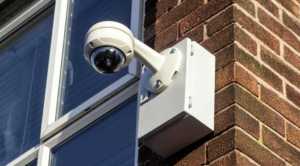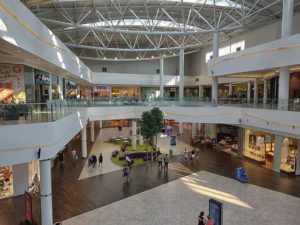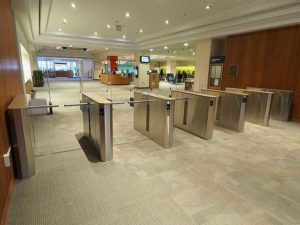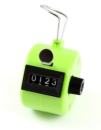People Counting: Eight Technologies to Measure Footfall
Footfall is the number of people entering an area, shop or building in a given time.
Businesses measure footfall for a variety of reasons: to save money, gain valuable analytics and key performance indicators, improve the visitor experience, to see current occupancy and to optimise operations.
Smart cities use the information to plan their services and manage the city, making information available over the Internet of Things.
Retailers use footfall figures to calculate sales conversion rate, dwell times (eg how long a person spends at a display or in a shop), queueing times, popular store areas, etc.
Transport agencies use footfall to count passengers, cross-check passenger numbers with fares, plan timetables and routes.
Whatever the reason - there are a range of technologies to choose from with differing capabilities, prices and accuracies.
Video Counting – WiFi Mobile Probes – WiFi Signal Strength – Mobile App – Thermal Sensors – Infra-Red Beam – Turnstiles – Manual – Learn More
Video Footfall Counting
In video footfall counting, an overhead IP or CCTV camera tracks people's movements. The camera connects to a people counter which analyses the video stream, detecting and recording how many people pass through the counting zone. The people counters send back data to a central database or make the information available to the Internet-of-Things.
Advantages
- One of the most accurate methods at 98%.
- Easy to verify remotely that the counting system is working correctly.
- System can be scaled up to include other areas
- Privacy – people are not identified
- Counts can be integrated with POS systems in real-time
- Can measure dwell time and occupancy
- Can generate heat maps of popular areas
- Can exclude staff from counts
- Handles wide entrances and outdoor counting
- Can be adjusted via software for individual situations – crowds, reflections, etc.

Disadvantages
- Installation takes longer than for simpler systems like beam counters.
For more on on video people counting see the Retail Sensing site.
Smartphone Counting - WiFi Probe Requests
There are several ways to count people using mobile signals. One is to collect Wi-Fi probe request signals from shoppers’ smartphones.
Advantages
- Can record returning customers.
- Can count inside and outside.
- Can measure dwell times.
- Can track people and generate heat maps of popular areas.

Shopping centres use video footfall counting
Disadvantages
- Privacy concerns - the ethical and data protection considerations of knowing exactly how often a person returns to a location and where they went. Data collection and processing to track and understand shoppers' behaviour likely qualifies as personal data and will come under data protection regulations.
- Only counts those carrying a smart phone with Wi-Fi switched on.
App Counting on Mobile Phones
An opt-in mobile app communicates when it is approaching and inside a store.
Advantages
- Can record returning customers.
- Can count inside and outside a store.
- Can track people to generate heat maps of popular areas.
- As it is opt-in, privacy concerns are reduced.
- Wide entrances and outdoor counting covered.
Disadvantages
- Data is only collected from those who have installed the app hence not an accurate method of measuring footfall.
Counting using Wi-Fi Patterns and Signal Strengths
Uses the received signal strength of a WiFi link to estimate the number of people in the area of interest, without requiring them to carry any device like a mobile phone. The strength of the signal is first measured in the absence of people for comparison.
Advantages
- No privacy issues.
- 98% accurate.
- Will work through walls.
Disadvantages
- Can only provide counts, not, for example, dwell times and heat maps.
- Provides occupancy counts, not entries and exits.
- Can’t verify counts without using an independent method.
- As yet are mainly experimental systems.
Thermal Sensors
Positioned above an entrance, thermal sensors identify people by measuring their body heat.
Advantages
- Quoted accuracies are between 96 and 98%.
- Privacy – people are not identified .
- Network together for wide areas.
Disadvantages
- Accuracy can be affected by the ambient temperature within the counting area being above or below a certain value. Low ceilings can also reduce the accuracy.
- Have difficulty measuring the dwell time of people.
- Needs a camera or other method to verify counts.
Infra-Red Beam Systems
A sensor sends a beam to a reflector on the opposite side of the doorway. When someone passes through, the beam breaks and a person is counted. These were popular twenty years ago – now higher accuracy and more information is generally needed for most applications.
Advantages
- Privacy – people are not identified.
- Low cost.
- Easy to install.
- Can communicate with a server in real-time.
Disadvantages
- Accuracy tends to decrease with wide or busy entrances. Direct sunlight onto the beam will also affect the system. Difficult conditions can bring accuracy down to 80%.
- Don’t measure dwell time or provide heat map data.
- Needs a camera or other method to verify counts.
Turnstile
A turnstile is a kind of gate which lets one person in at a time. They provide an accurate count of entries, which is why our video people counting product is called “Video Turnstile”. Drop Arm Optical Turnstiles are beam counters which raise a mechanical arm to let people through.

Drop arm optical turnstile by Fabtron CC BY-SA 4.0
Advantages
- Extremely accurate.
- Good where security is needed.
Disadvantages
- Not suitable for shops and areas where easy access is needed.
- Dwell times and heat maps not available.
Manual Counts

Hand-held tally counters are the least sophisticated of solutions. A person stands clicking the tally counter (or a tally counter app on a mobile phone) whenever anyone passes through the entrance. This may be acceptable for a one-off people counting excercise, but is obviously unsuited to continuous monitoring. Tally counters were once used in nightclubs and bars to monitor occupancy, but have now been replaced by automatic counting systems.

Tally Counter App can be
used for manual footfall counts
Advantages
- Cheap if done on a small-scale for a short time.
Disadvantages
- Accuracy varies depending on number of people entering and the person doing the counting
- Verification of counts not possible unless another method is also used.
- Labour-intensive.
- Can’t be automatically integrated with POS system
Learn More
To find out more - or to ask our advice on your footfall measurement project - enter your details below.
References and More Information
How a CCTV, or IP Camera, People Counting System Works, Retail Sensing. Accessed 17 October 2019
Osama T. Ibrahim, Walid Gomaa, Moustafa Youssef, CrossCount: A Deep Learning System for Device-free Human Counting using WiFi. IEEE Published: 2019
Web learning resources for the EU General Data Protection Regulation- Accessed 20 September 2019
Human Sensing, Windmill Software.
Occupancy Monitoring via IoT, Windmill Software.
Disclaimer: Windmill Software have been involved in creating the software used by Retail Sensing to count footfall. For more details e-mail sales@biodataltd.com.